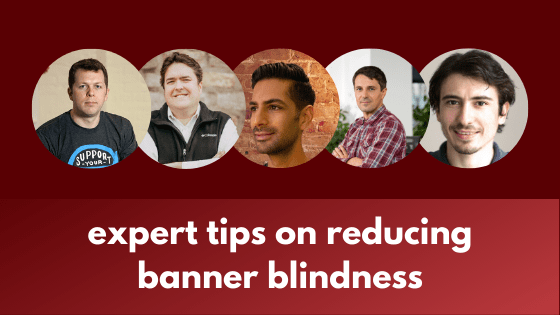We asked leaders from BuySellAds, Kevel, AdButler, PubNative and Bannersnack to share their best tips for reducing banner blindness. Here’s what they said.
Banner blindness has traditionally been used to describe the user tendency to knowingly or unknowingly ignore banner ads, now however, it encompasses a broader range of ad-related elements. “Banner blindness is a learned behavior. In our latest eyetracking study, we observed that some participants have learned to skip past the ad presented at the top of the Google search results, even though its visual design is far from the traditional banner ad,” says the latest update to N/N Group study.
Users ignoring ads leads to reduced viewability score and fewer clicks, and consequently, lower ad revenue for publishers. As of now, display ads have a mere 0.05% CTR across all ad formats and placements. Whereas rich media ads offer up to 0.1% CTR. Rich media ads use audio, video, and animations to make ads more interactive. And as per Coalition for Better Ads, some these formats can be intrusive. For instance, if you use autoplaying video ads with the sound on, you are promoting an intrusive ad experience.
This puts publishers in a weird situation—how can you improve ad viewability without being intrusive? To answer this, we contacted multiple ad tech experts. Here are some measures they suggested:
Todd Garland, BuySellAds

Todd Garland started BuySellAds over 12 years ago as a passion project from his own frustration with how unfair the world of digital advertising was for publishers. BuySellAds now represents thousands of publishers while connecting advertisers with passionate, niche audiences at scale.
Context is everything in advertising. When you serve relevant ads that respect the user experience, people see them as appropriate suggestions, and not the in-your-face irrelevant ads they commonly ignore these days. Banner blindness will melt away once audiences realize ads are curated and in a proper context.
Choosing high-quality publishers can be essential for seeing campaign success and avoiding the pitfalls of modern advertising online. Marketers who purchase advertising from programmatic networks have no idea where their ads are being served or the quality of the publishers they’re working with. It’s a dangerous game that’s still way too common.
The end result of that paradigm is banner blindness. If we’re serious about removing banner blindness from the equation, we need to start having a conversation about where ads are running and how they’re being served to relevant audiences. For us, that all starts with building the proper contextual ecosystem for marketers and publishers
Rajiv Khaneja, AdButler

Rajiv Khaneja is a serial entrepreneur, investor, and Founder of AdButler, a leading AdTech Platform.
Solving banner blindness is a fantastic opportunity for publishers. Publishers who get this right will attract better advertisers and happier users.
Banner blindness is the brain’s response to irrelevant content. The brain is really good at filtering out bad patterns. Uncurated, irrelevant ads are quickly skipped.
We recommend publishers offer innovative ad units, such as native, sponsored listings, sponsored video, rich media, and responsive ads.
We also recommend that publishers give advertisers the opportunity to target and test their ads granularly. More targeted, relevant ads that fit with the context of the content will garner more attention. A great way to do this is with a self-serve portal allowing advertisers to test and target different ads.
Florin Demian, Bannersnack

Florin Demian is a Product Manager at Bannersnack, an easy to use, cloud-based design platform with over 1,7 million active users. Although he started off as an Ad Ops Manager, Florin’s interest gradually shifted towards product development, strategy, and customer satisfaction.
To combat banner blindness, we need to look into what caused this web phenomenon in the first place. Most users have developed advanced mechanisms to overlook banners because they’ve previously been exposed to many lousy, irrelevant, or spammy ads.
To prevent banner blindness from occurring, try to create attractive banners that blend in with the surrounding environment. The user is less likely to be visually distracted or annoyed by your ads if you use fonts and colors that are similar to the hosting page.
Ad size and placement also play an essential role. For example, users tend to visually avoid the above-the-fold, right corner of a web page solely because sites are overusing that ad spot.
We also recommend lots of experimenting and A/B testing with different creative sets and strategies before scaling.
James Avery, Kevel (previously Adzerk)

James Avery is the founder and CEO of Kevel, an API platform that enables brands like Ticketmaster and Yelp to easily build innovative, custom ad servers. He has been writing code and starting companies for the past 20 years, while also writing books for O’Reilly, Wrox, and Microsoft Press.
The future of advertising is very bespoke native advertising that integrates with how a user uses your site or app. Google, FB, and Amazon aren’t winning because they are showing banners, they are winning because they have built amazing ad platforms that work for both users and brands.
Ionut Ciobotaru, PubNative

Ionut Ciobotaru is the founder and CEO of the mobile advertising platform PubNative, a Berlin-based startup providing monetization solutions for app publishers. Previously working as a Product Manager at AppLift, Ionut has over 7 years of experience in the mobile advertising ecosystem.
Within the in-app environment, one way to overcome banner blindness is to ensure that mobile banners appear less like banner ads by including native/moving elements and keeping them visible for at least 15 seconds, while being mindful about frequency capping.
Mobile app sessions are considerably longer than mobile web/desktop and the relative amount of screen estate is significantly greater than desktop for individual units as there are fewer ad placements in mobile.
On the MREC and native front, in-app visibility is similar to that on mobile web, but due to the ability to cache the ads, viewability should be higher than mobile web where loading time is key.
FAQs
Banner blindness, or ad blindness, occurs when people ignore or avoid banner ads. The reason for this is that they often feel irritated by the page. Their attention is usually diverted by other content on the page, so they don’t respond to banners.
The Best Way to Avoid Banner Blindness
i. Don’t follow the ad look. Try not to make your content look like an advertisement.
ii. Make sure your ads are effective. Run an A/B test with your target audience.
iii. You can choose another option.
Banner blindness is a real problem. Banner ads are so common that people no longer notice them. If people don’t see an advertisement, they can’t learn about the product or service being offered, and the advertiser will just waste money.

Shubham is a digital marketer with rich experience working in the advertisement technology industry. He has vast experience in the programmatic industry, driving business strategy and scaling functions including but not limited to growth and marketing, Operations, process optimization, and Sales.







